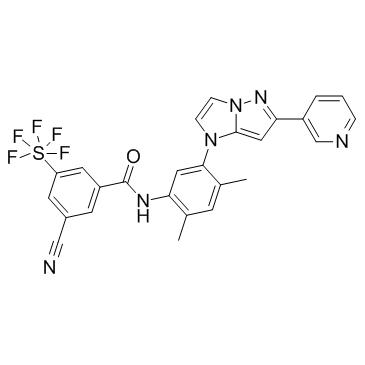| Description |
BAY-826 is a selective and potent TIE-2 inhibitor with Kd of 1.6 nM, respectively.
|
| Related Catalog |
|
| In Vitro |
BAY-826 is a selective and potent inhibitor of TIE-2 (dissociation constant = 1.6 nM) and binds with similar high affinity to only 4 of 456 tested kinases, namely, TIE-1, DDR1, DDR2, and Serine/threonine-protein kinase 10 (LOK) (dissociation constant = 0.9, 0.4,1.3, and 5.9 nM).The high biochemical affinity for TIE-2 translates into very potent cellular mechanistic activity with an EC50 of about 1.3 nM for inhibition of TIE-2 autophosphorylation in human umbilical vein endothelial cells. The TIE-2 inhibitor BAY-826 is tested for its acute growth inhibitory as well as anti-clonogenic properties in all four mouse glioma cell lines. BAY-826 is highly selective against other angiogenic kinases, such as VEGFR, fibroblast growth factorreceptor (FGFR), or Platelet-derived growth factor receptor (PDGFR), and affects VEGF-stimulated proliferation of HUVEC only atμM concentrations, respectively.
|
| In Vivo |
TIE-2 inhibitor (BAY-826) improves tumor control in syngeneic mouse glioma models. Co-treatment with BAY-826 and irradiation is ineffective in one model (SMA-497), but provided synergistic prolongation of survival in another (SMA-560) cell. TIE- 2 inhibition may improve tumor response to treatment in highly vascularized tumors such as glioblastoma. We observe a reduction in tumor vessels upon BAY-826 treatment with highest vessel density[1].
|
| Cell Assay |
Murine SMA-497, SMA-540, SMA-560, and GL-261 glioma cells are used.The cells are commonly cultured as adherent monolayers in Dulbecco`s modified Eagle medium supplemented with 10% heatinactivated fetal calf serum and 2 mM glutamine. Cells are irradiated in a Coradiation source at 1, 3, and 9 Gy. The cells are pre-incubated for 10 min in the 37°C incubator either with 0.1% DMSO as control or 1μM BAY-826. TIE-2 autophosphorylation is induced for 20 min with either 4 mM Na3VO4 or with 400 ng/mL COMP-ANG-1 in the presence of either 0.1% DMSO or 1 μM BAY-826[1].
|
| Animal Admin |
Following anesthesia, a burr hole is drilled in the skull 2 mm lateral to the bregma. The needle of a Hamilton syringe is introduced to a depth of 3 mm. A volume of 2 μL of a single cell suspension in PBS is slowly injected into the right striatum. In female and male VM/Dk mice (in-house husbandry) 5×10 3 SMA glioma cells are implanted, whereas in female C57Bl/6 mice (Charles River) 2×104 GL-261 cells are implanted (n =10 per group). The mice employed have body weights >20 g. Systemic treatment with BAY-826 is performed by oral gavage (100 mg/kg body weight daily) or the solvent (10% Ethanol/40% Solutol/50% Aqua dest), respectively [1] .
|
| References |
[1]. Schneider H, et al. J Neurochem. 2017 Jan; 140(1):170-182. doi: 10.1111/jnc.13877. Epub 2016 Dec 12.Novel TIE-2 inhibitor BAY-826 displays in vivo efficacy in experimental syngeneic murine glioma models.
|
